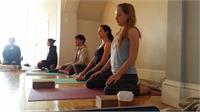 Welcome to our Yoga Type series!
Welcome to our Yoga Type series!
Yoga is steeped in history and tradition. It began over 5,000 years ago. Several different types of yoga have emerged and each offer their own unique practice. Our newest series will explore various yoga practices.
Jess, a Yoga District teacher, explores the ancient tradition of Ashtanga Yoga and how it does not need to be an intimidating practice.
Feel free to attend one of our Ashtanga inspired classes or any upcoming workshop.
Sign up here for the classes.
If you’re wondering about Ashtanga yoga then don’t be afraid to try it out! It builds strength, flexibility, coordination and symmetry in the body through set sequences.
Ashtanga Yoga History & Overview
Ashtanga can be a very intimidating practice because of its strong ties to tradition and rigid sequencing. Yet it is actually the root of all modern vinyasa flow practices. In the 1950’s, Ashtanga yoga began to spread to the West via K. Pattabhi Jois, a direct student of Krishnamacharya. Eventually westerners adapted the practice to better suit their needs and the needs of their students. It evolved into Power Yoga and other more familiar types of yoga.
Ashtanga is generally practiced Mysore style. This style originated in Mysore, India. In Mysore practice, students are not led together by a teacher but instead practice at their own pace. The teacher gives them poses of a set sequence one by one that they must memorize. Students may not progress past the pose they have been given or make modifications to either the sequence or each pose.
The most commonly practiced sequence is the Primary Series:
- It starts with the Sun Salutations and standing poses like warriors and triangles (the same standing poses that we know and love)!
- The sequence then moves towards a series of seated postures that become progressively more pretzel-like. There’s a vinyasa (jump back to chaturanga, upward facing dog, downward facing dog, jump right back through to the seat) between each seated posture.
- All Ashtanga practices end with the finishing series. It starts with 5 rounds of bridge or wheel pose and then moves into cooling inversions followed by meditative postures to prepare the body for rest.
Principles of Ashtanga
Whether you’re a Mysore practitioner or simply a yogi that dabbles in led primary series then the principles of the practice are the same:
- pranayama (breath focused)
- bahnda (core engagement)
- drishti (gaze)
You may have heard these terms used in a vinyasa flow class since they are so integral to the vinyasa method.
Ashtanga Yoga Classes
 Ashtanga yoga is held very sacred to some who only practiced it Mysore style. Yet, others wish Ashtanga to be accessible to a wider group of practitioners.
Ashtanga yoga is held very sacred to some who only practiced it Mysore style. Yet, others wish Ashtanga to be accessible to a wider group of practitioners.
Teachers who hold a more progressive view may lead primary or modified primary series classes. These classes invite students to try out the full series even if they have to modify or skip some poses (or some of the 40+ vinyasas typically practiced in a primary series).
Ashtanga doesn’t have to be intimidating! Yoga District offers Ashtanga inspired classes along with three weekly led primary series. Don’t worry, we keep it approachable and will help you to modify the sequence and poses to fit your body and level.
 Introduction to Ashtanga Yoga Workshop
Introduction to Ashtanga Yoga Workshop
Ashtanga Yoga is now one of my favorite practices. I love the mobility, symmetry, and awareness it cultivated in my body.
In a typical workshop: you’ll learn the origins of Ashtanga, be instructed in Pranayama (breath-work work), run through a 90-minute asana practice (break down the poses and transitions) of modified primary sequence series.
Come ready to sweat, deepen your practice and connection to the roots of flow yoga.
Join me and you might just fall in love with the Ashtanga too!


